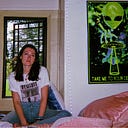No One Cares about Rappers or Drug Addicts: Some Thoughts on Lil Peep’s Death (November, 2017)
“When I die, You’ll love me” reads one of Lil Peep’s final Instagram captions before his untimely death — a potential cry for help lost in a sea of adoration characterized by likes and comments.
Gustav Åhr, better known as “Lil Peep,” was a social media icon and breakthrough Soundcloud rapper, who created and then mastered a new wave genre of alternative music: emo-rap.
Peep was found dead late on November 15th, presumably of an overdose. In a world of kids like Lil Pump, who pop xans for intangible clout, Lil Peep was a struggling victim.
Peep self medicated, treating his depression with Xanax and other prescription drugs. Lil Peep wasn’t alone in this act, half the rap songs charting right now center around drugs. Post Malone’s latest hit “rockstar” focuses on “f*ckin hoes and poppin pillies” in a desperate attempt to return to the rockstar culture of the 1980’s and 90’s. No shade to Post as he’s just another product of our weird drug culture.
Lil Peep was a Marilyn Manson to 2017’s outcasts. Starting as a homeless high school dropout, Peep was a runway model, rapper, and singer before his untimely death. Found “unresponsive” on the tour bus, news soon leaked to Twitter about the “sad boi” icon’s death.
In an industry full of people who are widely regarded as being immoral, Lil Peep was an activist challenging racism and showing inclusion in his content. Taking to Twitter earlier this month, he told fans “do ur research on the artists u support” before asking for names of racist and homophobic rappers. His music video “Girls” stars a diverse cast of women, including Peep’s on and off lover–“nu goth” Instagram star TooPoor. Peep fought against having the usual boring array of skinny, blonde girls who all look identical and have unachievable conventional good looks. Peep was a proud bisexual, coming out via Twitter in August. In a world of hyper masculine rappers, Peep wasn’t hiding behind a guise of heteronormativity, unabashedly dressing in high fashion looks, covering his body and face in tattoos, and constantly dying his hair different neon shades.
The twenty-one-year-old was open about his struggles with depression and anxiety, acting as a modern Kurt Cobain to a new generation of misfits. As the music scene strays farther from “emo” music, even the Vans Warped Tour is coming to an end soon, Lil Peep was an alternative voice in a homogenous hip hop scene. His music was more reminiscent of Teen Suicide than Drake, but still retained a wholeheartedly trap identity. He gave a voice to teenagers who needed someone who faced relatable struggles. Someone who got them. When I was fourteen, I turned to bands like My Chemical Romance, but in 2017, kids believed in someone like Lil Peep.
Lil Peep was a lot of things. What has come up most following his apparent suicide is his identity as a drug addict. His songs were filled with lyrics about “drugs in his nose.” The “gothboiclique” artist’s tendency to rap about his various addictions was no secret, but nobody did anything about it.
Social media flooded with individuals exploiting Peep’s death to advertise the hazard of rap culture and drug use. Is that what someone’s death is supposed to be? Drug overdoses are a pervasive issue in the United States. Outside of pop culture, where icons like A$AP MOB leader A$AP YAMS die from unfortunate drug combinations, opioids are a raging epidemic. Despite being an ongoing issue since the 1990’s, only this summer was the opioid problem in the United States officially declared a national crisis by the Center for Disease Control and Prevention (CDC). With approximately ninety people dying everyday from opioid overdoses alone, drug addiction is a pressing issue.
Next to eighty-nine others lays Lil Peep, one victim who didn’t wake up from his high in the morning. Yet, his death hasn’t been taken seriously. Mocked as nothing more than a stupid kid, Lil Peep is reduced to a modern D.A.R.E campaign ad.
No one took the time to think about Peep as a product of something out of his control. Mental illness and addiction are not easily “fixed,” but had someone in Lil Peep’s life done something, then maybe he would still be alive. Eerily, the rapper posted a video last night before his death saying how he was “on six xanax” and would see his El Paso concert crowd “later.” On “The Way I See Things” he sung how he “got a feelin’ that [he’s] not gonna be here for next year,” though Peep did live to the next year (2016), only to not wake up on his tour bus barely one year later.
Lil Peep was one rapper, one addict, and one unfortunate victim to mental illness. His life deserves celebration and his death: respect. Stop mocking a creator’s death because he didn’t chart on Billboard. Don’t blame a dead victim for a drug overdose that could have been prevented by someone else. Care about artists. Fight to change an industry and culture that celebrates toxic behavior and glorify self destruction. Do better.
